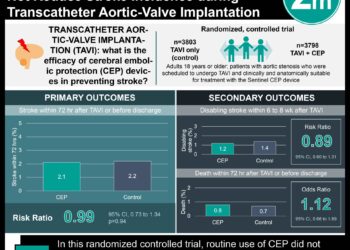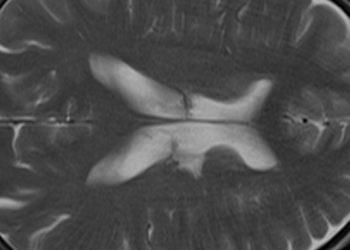2 Minute Medicine Rewind March 24, 2025
1. In sub-acute stroke patients, occupational therapy in conjunction with dual transcranial direct current stimulation showed significantly improved improvements motor function and cortical activity
Evidence Rating Level: 1 (Excellent)
Stroke often leads to upper limb motor dysfunction, and current traditional rehabilitation methods show limited efficacy. Dual transcranial direct current stimulation (tDCS), which modulates cortical excitability by stimulating both hemispheres, has been proposed to enhance neural plasticity and functional recovery when combined with occupational therapy (OT). This randomized, double-blind, controlled study examined the effects of OT synchronized with dual tDCS on upper limb motor function and electroencephalography (EEG) power in subacute stroke patients. Forty-five subacute stroke patients were randomized into two groups: the experimental group (n = 22) received real dual tDCS with OT, while the control group (n = 23) received sham tDCS with OT. Both groups underwent five 40-minute sessions per week for two weeks. Functional outcomes were assessed using the Fugl-Meyer Assessment Upper Extremity (FMA-UE), Modified Barthel Index (MBI), and Action Research Arm Test (ARAT). EEG power was analyzed through Delta/Alpha Ratio (DAR) and pairwise derived Brain Symmetry Index (pdBSI). The experimental group demonstrated significantly greater improvements in FMA-UE (p < 0.001), MBI (p = 0.034), DAR in the primary motor cortex (p = 0.022), and pdBSI (p = 0.025) compared to controls. These findings suggest that dual tDCS combined with OT enhances motor function and normalizes cortical activity, supporting its use as an effective stroke rehabilitation strategy.
Bilateral ankle dorsiflexion force control impairments in older adults
1. Older adults showed significantly reduced neuromuscular control, specifically, lower force accuracy, force variability, and complexity.
Evidence Rating Level: 2 (Good)
This study examined the age-related deficits in bilateral ankle dorsiflexion force control as this could contribute to the increased fall risk in older adults. A total of 25 older adults (mean age: 64.9 years) and 25 younger adults (mean age: 23.0 years) performed isometric ankle dorsiflexion tasks at 10% and 40% of their maximum voluntary contraction (MVC) under both vision and no-vision conditions. Force control was evaluated using measures of accuracy, variability, complexity, and interlimb coordination. Results indicated that older adults exhibited significantly lower force accuracy, characterized by greater overshooting errors at lower force levels, increased force variability, and reduced complexity, suggesting diminished neuromuscular control. Additionally, they demonstrated impaired interlimb coordination, with reduced anti-phase coordination and lower bilateral motor synergies, indicating decreased adaptability in force modulation between limbs. Correlation analyses further revealed that increased age was significantly associated with decreased force complexity. These findings suggest that aging impairs sensorimotor integration and bilateral motor control in the lower extremities, potentially contributing to balance instability and increased fall risk. Given the importance of ankle dorsiflexion for gait and postural stability, these results emphasize the need for targeted rehabilitative interventions, such as neuromuscular training, functional electrical stimulation, or robotic-assisted therapy, to enhance lower limb motor control in older adults. Future studies should explore the underlying neurophysiological mechanisms and develop evidence-based training protocols to mitigate the impact of aging on lower extremity function.
1. Aspiration pneumonia in post-stroke patients showed significantly increased 90-day mortality, longer hospital stays, and more cardiovascular events at one year
2. Stroke patients admitted to the medicine ward had increased pneumonia risk compared to stroke unit admission
Evidence Rating Level: 2 (Good)
This retrospective cohort study analyzed the impact of stroke severity on the risk of aspiration pneumonia in patients admitted to a stroke unit versus a general medical ward. Using data from the Qatar Stroke Database, 9,197 patients with acute ischemic stroke admitted between 2014 and 2024 were reviewed. The study compared clinical characteristics, 90-day mortality, functional outcomes (modified Rankin Scale), and hospital length of stay between stroke patients who developed aspiration pneumonia (4.1%) and those who did not (95.9%). Patients who developed aspiration pneumonia were older, more often male, and had significantly higher National Institute of Health Stroke Scale (NIHSS) scores at admission (p<0.001). Stroke subtype also influenced risk, with large vessel disease, cardioembolic stroke, and undetermined etiology associated with higher pneumonia rates. Patients with aspiration pneumonia had worse outcomes, including higher 90-day mortality (16.9% vs. 1.9% for NIHSS 5–9, p<0.001; 22.3% vs. 13.8% for NIHSS >10, p=0.003), longer hospital stays (16.0 vs. 5.3 days, p<0.001), and more adverse cardiovascular events at one year. Admission to a general medical ward increased pneumonia risk compared to stroke unit admission (adjusted OR 1.56, 95% CI: 1.05-2.31). The study highlights the importance of early dysphagia screening, targeted prevention strategies, and specialized stroke care in reducing aspiration pneumonia risk and improving patient outcomes.
Perceptions of music listening for pain management: a multi-method study
1. Using music for pain relief is highly valued by participants but requires a proactive and personalized approach
2. The use of music in the healthcare setting can have negative outcomes depending on the kind of music and if it is used at an inappropriate time highlighting the importance of a patient-centered approach
Evidence Rating Level: 3 (Average)
This multi-method study investigated healthcare recipients’ perceptions of music listening as a pain management strategy, focusing on attitudes, implementation challenges, and subjective experiences. This study followed up with 169 participants from a prior randomized trial that assessed the impact of different music genres on pain tolerance. The follow-up included a quantitative survey and in-depth qualitative interviews. Results showed that most participants were receptive to using music for pain relief, particularly for emotional distress (e.g., anxiety, stress) rather than physical pain. However, attitudes varied based on individual preferences, the type of pain, and contextual factors. Barriers to implementation included forgetfulness, not considering music as an option, and social discomfort in healthcare settings. Some participants expressed concern that listening to the “wrong” music or using music in an inappropriate context could be ineffective or even distressing. Participants emphasized the importance of personal autonomy in choosing music, with many preferring to select their own genre and listening method. A proactive role by healthcare professionals in suggesting music use was identified as a key factor for improving integration into clinical settings. The study highlights the importance of patient-centered approaches to music-based pain management, recommending personalized interventions that accommodate individual preferences, situational appropriateness, and healthcare provider engagement. These findings suggest that while music can be an effective non-pharmacological intervention, its benefits depend on careful consideration of patient needs, preferences, and healthcare context.
1. In older adults post-acute ischemic stroke, benzodiazepine initiation was associated with an increase in 10-day fall and fall-related injury risk.
2. The highest risk increase was seen in patients aged 65-74 years old and those with minor acute ischemic stroke.
Evidence Rating Level: 2 (Good)
This study examined the association between benzodiazepine initiation and the risk of falls or fall-related injuries (FRIs) in older adults following acute ischemic stroke (AIS). Given that benzodiazepines are frequently prescribed for poststroke insomnia, anxiety, and agitation but have known adverse effects, including sedation and impaired balance, this study aimed to quantify their short-term risks. Using a target trial emulation approach with data from the “Get With The Guidelines”-Stroke Registry and Mass General Brigham electronic health records, 3,059 AIS patients aged 65 years and older were analyzed. Patients with prior benzodiazepine use or a history of stroke within the past year were excluded. Among them, 495 initiated benzodiazepines within three days of admission, while 2,564 did not. Standardized analyses revealed that benzodiazepine initiation was associated with an increased 10-day fall/FRI risk (694 vs. 584 events per 1,000 patients; risk difference: 110 per 1,000, 95% CI 89–125). The highest risk was observed in patients aged 65–74 years (risk difference: 142 per 1,000) and those with minor AIS (risk difference: 187 per 1,000). These findings highlight the need for caution when prescribing benzodiazepines in the acute poststroke period, particularly for ambulatory patients at higher fall risk. Alternative approaches, including non-pharmacological interventions and safer pharmacologic options, should be considered to mitigate these risks.
Image: PD
©2025 2 Minute Medicine, Inc. All rights reserved. No works may be reproduced without expressed written consent from 2 Minute Medicine, Inc. Inquire about licensing here. No article should be construed as medical advice and is not intended as such by the authors or by 2 Minute Medicine, Inc.







